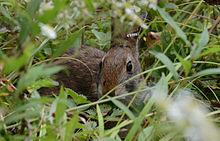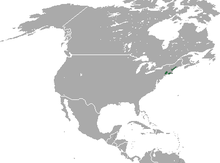Last week, our new friend Andrea Petrullo visited our classroom seeking our assistance in helping to reestablish the New England Cottontail rabbit to Eastern Connecticut. The New England Cottontail rabbit is the indigenous representative. The rabbits most folks see are the Eastern Cottontail, an introduced variety due to over-hunting at the turn of the century (1900s). Ms. Petrullo showed the children how to tell the difference between these types of rabbits (length of ear set basically) and pointed out the physical characteristics of rabbits in general. Here's some information from the internet:
| New England cottontail[1] | |
|---|---|
 | |
| Scientific classification | |
| Kingdom: | Animalia |
| Phylum: | Chordata |
| Class: | Mammalia |
| Order: | Lagomorpha |
| Family: | Leporidae |
| Genus: | Sylvilagus |
| Species: | S. transitionalis |
| Binomial name | |
| Sylvilagus transitionalis (Bangs, 1895) | |
 | |
| New England Cottontail range | |
The New England cottontail (Sylvilagus transitionalis), also called the gray rabbit, brush rabbit, wood hare, wood rabbit, or cooney, is a species of cottontail rabbit represented by fragmented populations in areas of New England, specifically from southern Maine to southern New York.[3][4][5] This species bears a close resemblance to the eastern cottontail (Sylvilagus floridanus), which has been introduced in much of the New England cottontail home range. The eastern cottontail is now more common in it.[6]
Litvaitis et al. (2006) estimated that the current area of occupancy in its historic range is 12,180 km2 (4,700 sq mi) - some 86% less than the occupied range in 1960.[3] Because of this decrease in this species' numbers and habitat, the New England cottontail is a candidate for protection under the Endangered Species Act. Cottontail hunting has been restricted in some areas where the eastern and New England cottontail species coexist in order to protect the remaining New England cottontail population.[7]
Rabbits require habitat patches of at least 12 acres to maintain a stable population. In New Hampshire, the number of suitable patches dropped from 20 to 8 in the early 2000s. The ideal habitat is 25 acres of continuous early successional habitat within a larger landscape that provides shrub wetlands and dense thickets. Federal funding has been used for habitat restoration work on state lands, including the planting of shrubs and other growth critical to the rabbit's habitat. Funding has also been made available to private landowners who are willing to create thicket-type brush habitat which doesn't have much economic value

No comments:
Post a Comment
I am always willing to receive feedback. Comments will not appear on the blog, rather they will go directly to me. Thanks.